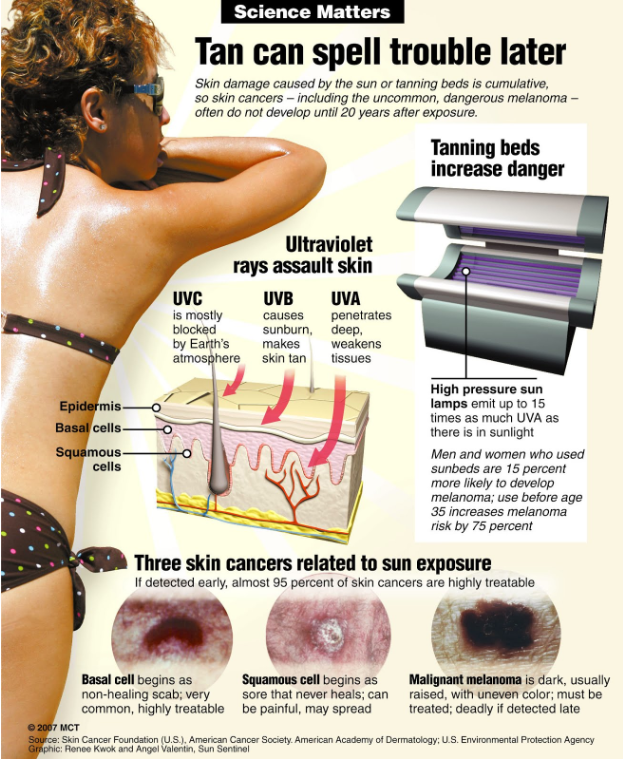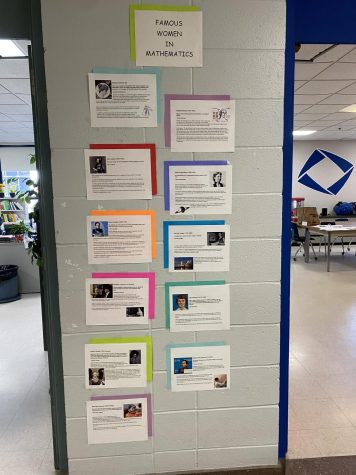Hot Button: Tanning Beds and Their Deadly Consequences
June 9, 2014
Even though this past winter on Cape Cod was rainy and gray, golden, tan bodies still could be found. Indoor tanning beds are an easy method of achieving a bronze glow, even when the sun is shy. But with more research being conducted and the truth about tanning coming out, the phrase “healthy tan” is an oxymoron.
According to a study done by the Journal of American Medical Association Dermatology, there are more cases of skin cancer as a result of indoor tanning than there are cases of lung cancer as a result of smoking. This dangerous habit of indoor tanning has been proven to be harmful and even labeled as “carcinogenic to humans.”
During prom and graduation season, teens tend to head to the tanning beds so they can appear bronzed for the big occasions. Over the years, teenagers have picked up this risky pastime. But with further research, the consequences of indoor tanning beds on younger people have become more concerning. The Skin Cancer Foundation states that people under the age of 30 who use indoor tanning beds increase their risk of getting melanoma by 75 percent.
Sarah Anderson, a sophomore, has been using tanning beds for one year. “I only do it before big events, like before I went to Prom and before I go on big vacations,” she said. Anderson goes to Tanlines in Centerville. “I do it so I can have a little golden tan and not look so pale. I just like to look tan and I think I look better with some color,” she said.
Mrs. Patricia Tucker, one of the school nurses at BHS, has had a close call with skin cancer herself and she does not agree with the use of indoor tanning beds.
“I disagree with anyone, particularly teens, using any form of indoor tanning. In fact, I think it should be illegal for parents to sign consent for anyone 18 years or younger. I think these devices should be banned,” she said.
One serious possible side effect of using tanning beds is increased risk of contracting skin cancer. Scientific studies indicate that increased exposure to UV rays can result in changes of the DNA in skin cells that could eventually lead to cancerous growths.The deadliest form of skin cancer is melanoma and it is linked to having too much sun exposure and UV rays, according to Dr. Mercola of Mercola The Web Health Center.
Glenna Kohl, a 2001 BHS graduate, tragically passed away in 2008 at the young age of 26 after a three-year battle with melanoma. Kohl was an active girl who only had one unhealthy activity: tanning. She was a lifeguard in the summer and her co-workers said she wore little sunblock in hopes of achieving a sunkissed glow. Her family also said Kohl attended tanning beds frequently. Her friends and family launched the Glenna Kohl Fund for Hope, Inc in 2009.
Colleen Kohl, Glenna’s mother, is very involved with the charity and is passionate about the cause. “The mission of the Glenna Kohl Fund for Hope is to carry on Glenna’s work to bring awareness to everyone about the dangers of melanoma and the importance of early detection and prevention,” Kohl said.
The Glenna Kohl Fund hosts annual fundraising events to spread awareness and also participates in several health fairs to increase knowledge on skin cancer. “We have gone into public schools to talk to students about what Glenna went through to try to get them to understand that overexposing your skin to the sun and tanning bulbs is a very dangerous activity. We try to let young people know that this is a very preventable disease if caught early, and to visit a dermatologist regularly to have their skin checked for any irregularities,” said Kohl.
The funds raised by the foundation are used for the Glenna O. Kohl Melanoma Research Fund at Mass General Hospital, to construct shade canopies for lifeguard towers and other popular public spaces, install sunscreen dispensers on Cape Cod, and to help other melanoma patients and their families with medical expenses and give donations to other melanoma awareness organizations.
Kohl said that Glenna’s biggest mission was to, “let other young people know about the dangers of overexposure to both the sun and tanning bulbs, so that they wouldn’t have to go through what she had endured.” The Glenna Kohl Fund for Hope also spreads the knowledge of alternate tanning methods. “There are good products out there now — both spray tanning and tanning lotions — that have improved over the years, and can be used to give a glow to the skin, without having to risk their health getting a lethal tan,” Kohl said.
Kohl said that it is saddening to see young kids use tanning salons, because that is how Glenna got started with her tanning obsession. Kohl believes Glenna would try to “dissuade young people from using tanning beds.” Kohl said that although Glenna felt she was addicted to getting a tan, she discovered the hard way how serious the risks were.
As well as being thought of as harmful, tanning beds are also being thought of as addictive as more research is being conducted. While the wish for a bronzed appearance is believed to be the biggest motivation for tanning, mood enhancement, socialization, and relaxation have also been reported as effects by tanners, the Skin Cancer Foundation reported. It has been suggested by scientists that one of the reasons tanning is so popular is the addictive UV rays.
“I think indoor tanning can be addictive. Many behaviors that make us feel good are addictive,” Tucker said.
May was Skin Cancer Awareness Month and with summer quickly approaching, it is important to be aware of all the risks. Just being out in the sun’s exposure without proper protection increases your risk of contracting skin cancer. The recommended SPF by dermatologists for daily activity is 30, but when participating in outdoor activities one should apply SPF 50, the Huffington Post reported. The higher the SPF value, the higher it’s ability to block the suns harmful rays.
According to the Skin Cancer Foundation, one out of three teenagers says she tans to look healthier. But it is important to remember that although a tan is temporary, the effects of too much UV radiation and sun exposure could be permanent.
Donations toward the Glenna Kohl Fund for Hope can be made at http://www.glennasfund.org.











